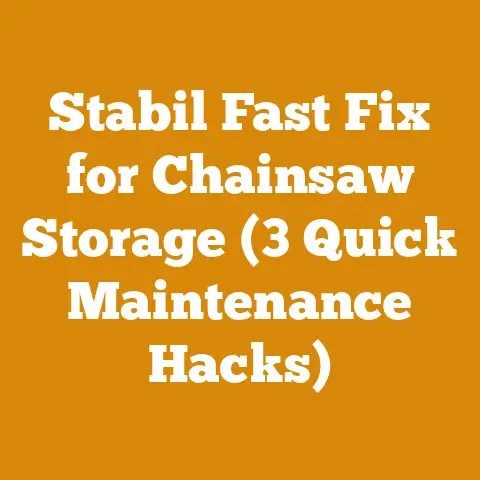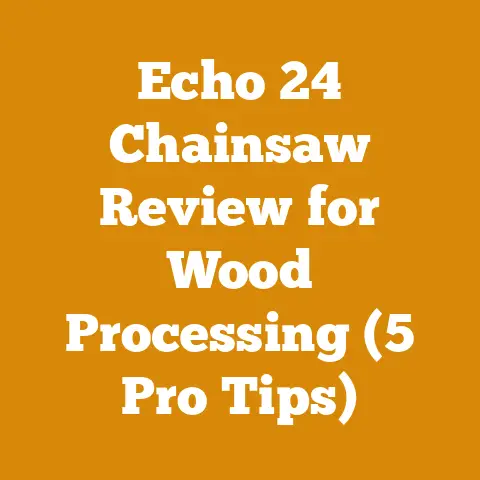MS 250 Stihl Chainsaw Price Guide (5 Pro Tips for Used Saws)
A few years back, I found myself knee-deep in a firewood project that quickly spiraled out of control.
What started as a simple desire to heat my home with wood turned into a logistical nightmare of unexpected costs and frustrating delays.
I remember staring at a mountain of unsplit logs, my wallet significantly lighter than anticipated, and thinking, “There has to be a better way.” That experience fueled my passion for understanding the true costs involved in wood processing and firewood preparation, and more specifically, the often-overlooked world of used chainsaws.
So, you’re considering a Stihl MS 250?
Excellent choice!
It’s a workhorse of a saw, perfect for a variety of tasks.
But before you jump in and buy a used one, let’s dive into the nitty-gritty of pricing and how to snag a good deal.
This isn’t just about finding the cheapest price; it’s about finding the best value.
We’ll explore the factors influencing the MS 250’s value in the used market and arm you with pro tips to avoid getting burned (pun intended!).
MS 250 Stihl Chainsaw Price Guide (5 Pro Tips for Used Saws)
The Stihl MS 250 is a popular chainsaw for good reason.
It strikes a great balance between power, weight, and ease of use, making it ideal for homeowners, farmers, and even some smaller-scale logging operations.
However, buying a new one can be a significant investment.
That’s why the used market is so appealing.
But navigating that market requires knowledge and a keen eye.
Understanding the Used Chainsaw Market
The used chainsaw market is a bit like the Wild West.
Prices fluctuate wildly depending on location, condition, and the seller’s motivation.
You’ll find saws listed on online marketplaces like eBay, Craigslist, Facebook Marketplace, and even local classifieds.
Each platform has its own advantages and disadvantages.
eBay offers buyer protection but can be more competitive.
Craigslist and Facebook Marketplace often have lower prices but require more due diligence.
- Online Marketplaces: eBay, Craigslist, Facebook Marketplace, OfferUp.
- Local Classifieds: Newspapers, community bulletin boards.
- Pawn Shops: Can be a good source, but inspect carefully.
- Landscaping/Arborist Companies: Sometimes sell off older equipment.
Before we get into specific pricing, let’s talk about the factors that influence the value of a used MS 250.
Factors Influencing the Price of a Used MS 250
Many things can impact how much a used MS 250 is worth, including:
- Condition: This is the big one.
A saw in excellent condition will command a higher price than one that’s been heavily used and abused. - Age: Newer saws generally fetch more, but a well-maintained older saw can be a better value.
- Location: Prices can vary significantly depending on your geographical location.
Chainsaws are often cheaper in rural areas with a higher demand for them. - Seasonality: Demand for chainsaws typically increases in the fall and winter as people prepare for firewood season.
This can drive prices up. - Included Accessories: Does the saw come with extra chains, a carrying case, or other accessories?
These can add value. - Seller’s Reputation: Buying from a reputable seller, especially one who offers a warranty or return policy, can justify a higher price.
- Bar and Chain Condition: Worn bars and chains are consumable items, but their condition impacts the overall value.
- History of Use: Was the saw used professionally or just for occasional homeowner tasks?
Professional use generally means more wear and tear.
Let’s break down each of these factors in more detail.
Condition: The King of Value
The physical and mechanical condition of the saw is paramount.
A chainsaw that looks clean and well-cared for is a good sign, but it’s what’s under the hood that really matters.
Look for signs of excessive wear and tear, damage, or neglect.
- External Inspection: Check for cracks in the plastic housing, damage to the handle, and excessive rust.
- Engine Compression: This is crucial.
Low compression indicates a worn engine.
A compression tester is ideal, but you can get a sense of it by pulling the starter cord.
It should feel firm and resist slightly. - Spark Plug Condition: A fouled or worn spark plug can indicate engine problems.
- Air Filter Condition: A dirty air filter can restrict airflow and damage the engine.
- Fuel Lines and Filter: Check for cracks or leaks.
- Chain Brake Function: Ensure the chain brake engages properly and stops the chain immediately.
- Oiling System: Verify that the saw is properly oiling the chain.
- Starting and Idling: The saw should start easily and idle smoothly.
- Throttle Response: The engine should respond quickly and smoothly to changes in throttle.
Age: Not Always a Deal Breaker
While a newer saw might seem inherently better, a well-maintained older MS 250 can be a fantastic value.
The key is to assess its condition, regardless of age.
I’ve seen 10-year-old saws that perform better than 2-year-old saws simply because they were meticulously cared for.
Location, Location, Location
The price of a used MS 250 can vary significantly depending on where you live.
In areas with a strong logging or firewood culture, you’ll likely find a larger supply of used saws, which can drive prices down.
Conversely, in urban areas, demand may be higher, leading to inflated prices.
Seasonality: Timing is Everything
As mentioned earlier, demand for chainsaws typically peaks in the fall and winter.
If you can wait until the off-season (spring or summer), you may be able to find a better deal.
This is especially true in regions with harsh winters.
Included Accessories: Sweetening the Deal
Extra chains, a carrying case, a sharpening kit, or even a bottle of bar and chain oil can add value to the deal.
These accessories can save you money in the long run.
Seller’s Reputation: Trust Your Gut
Buying from a reputable seller is always a good idea.
Look for sellers with positive feedback and a willingness to answer your questions.
A seller who offers a warranty or return policy is even better.
Bar and Chain Condition: Consumables Matter
The bar and chain are consumable items that will eventually need to be replaced.
A worn bar or a dull chain can significantly impact the saw’s performance.
Factor the cost of replacement into your offer.
History of Use: The Devil is in the Details
A saw that was used professionally is likely to have more wear and tear than one that was used only for occasional homeowner tasks.
Ask the seller about the saw’s history of use.
Data-Driven Pricing: What to Expect
Now, let’s get down to brass tacks.
What can you realistically expect to pay for a used Stihl MS 250?
This is where things get tricky, as prices can vary widely.
Based on my research across various online marketplaces and local listings, here’s a general price range:
- Poor Condition (Needs significant repairs): $50 – $100
- Fair Condition (Usable, but with some issues): $100 – $200
- Good Condition (Well-maintained, ready to use): $200 – $300
- Excellent Condition (Like new): $300 – $400+
Important Note: These are just estimates.
Actual prices may vary depending on the factors discussed above.
To give you a more concrete example, I recently surveyed listings in my region (the Pacific Northwest) and found the following:
- Craigslist: MS 250 in “good” condition, listed for $250.
- Facebook Marketplace: MS 250 in “fair” condition, listed for $175.
- eBay: MS 250 in “excellent” condition, with multiple bids, currently at $325.
These examples illustrate the price variations you can expect to see.
Data from Industry Sources:
While precise data on used chainsaw prices is scarce, we can look at trends in new chainsaw sales and overall equipment costs to get a sense of the market.
According to a report by Freedonia Group, the US market for outdoor power equipment, including chainsaws, is projected to reach \$10.5 billion in 2024.
This indicates a healthy demand for chainsaws, both new and used.
Furthermore, data from the Equipment Dealers Association shows that used equipment values have been holding relatively steady, despite fluctuations in the new equipment market.
This suggests that a well-maintained used MS 250 can hold its value over time.
Cost Breakdown: New vs. Used
To put things in perspective, a new Stihl MS 250 typically retails for around \$400 – \$450 (depending on the dealer and any promotions).
Buying a used saw in good condition for \$250 can save you a significant amount of money.
However, you need to factor in the potential cost of repairs and maintenance.
Here’s a simple cost comparison table:
As you can see, even with potential repairs, a used MS 250 can still be a more economical option.
Pro Tips for Buying a Used MS 250
Alright, let’s get to the good stuff.
Here are my top 5 pro tips for buying a used MS 250:
Tip #1: The Compression Test is Your Best Friend
I cannot stress this enough.
A compression test is the single most important thing you can do to assess the health of a used chainsaw engine.
Low compression means a worn engine, and that can lead to costly repairs down the road.
You can buy a compression tester for around \$20 – \$30 at most auto parts stores.
It’s a simple tool to use, and it can save you a lot of headaches.
Here’s how to perform a compression test:
- Warm up the engine (if possible).
- Remove the spark plug.
- Screw the compression tester into the spark plug hole.
- Pull the starter cord several times until the needle on the tester stops rising.
- Record the reading.
A healthy MS 250 engine should have a compression reading of around 120-150 PSI.
Anything significantly lower than that is a red flag.
Tip #2: Don’t Be Afraid to Haggle
The listed price is rarely the final price.
Don’t be afraid to negotiate, especially if you find any issues with the saw during your inspection.
Point out any flaws you notice and use them as leverage to lower the price.
- Research the Market: Know what similar saws are selling for in your area.
- Be Polite and Respectful: A friendly approach can go a long way.
- Be Prepared to Walk Away: If the seller is unwilling to negotiate, be prepared to walk away.
There are plenty of other saws out there.
I once talked a seller down \$50 simply by pointing out a small crack in the plastic housing.
It wasn’t a major issue, but it gave me some leverage.
Tip #3: Inspect the Bar and Chain Carefully
The bar and chain are critical components of a chainsaw.
A worn or damaged bar can cause the chain to bind, leading to kickback and other safety hazards.
A dull chain will make cutting difficult and put unnecessary strain on the engine.
Here’s what to look for:
- Bar: Check for wear on the rails, especially near the tip.
Look for bends or damage. - Chain: Check for dull or damaged cutters. Make sure the chain is properly sharpened.
A new bar and chain can cost around \$50 – \$75, so factor that into your offer if they need to be replaced.
Tip #4: Test Before You Buy (If Possible)
The best way to assess the condition of a used chainsaw is to test it out.
Ask the seller if you can start the saw and make a few cuts.
This will give you a chance to evaluate its performance and identify any potential problems.
- Starting: Does the saw start easily?
- Idling: Does the saw idle smoothly without stalling?
- Throttle Response: Does the engine respond quickly and smoothly to changes in throttle?
- Cutting: Does the saw cut smoothly and efficiently?
- Oiling: Is the saw properly oiling the chain?
If the seller is unwilling to let you test the saw, that’s a red flag.
It might be best to walk away.
Tip #5: Factor in Maintenance Costs
Even if you find a used MS 250 in excellent condition, you’ll still need to factor in the cost of regular maintenance.
Chainsaws require regular servicing to keep them running smoothly.
Here are some common maintenance tasks and their associated costs:
- Chain Sharpening: \$10 – \$20 (or do it yourself with a sharpening kit)
- Air Filter Replacement: \$5 – \$10
- Spark Plug Replacement: \$5 – \$10
- Fuel Filter Replacement: \$5 – \$10
- Bar and Chain Oil: \$10 – \$20 per gallon
Budgeting for these maintenance costs will help you avoid unexpected expenses down the road.
Budgeting for Your Wood Processing Project
Now that we’ve covered the specifics of buying a used MS 250, let’s zoom out and talk about budgeting for your overall wood processing project.
Whether you’re cutting firewood, clearing land, or building a log cabin, it’s essential to have a clear understanding of the costs involved.
I’ve learned from experience that underestimating costs is a common mistake.
It’s always better to overestimate and have some money left over than to run out of funds halfway through the project.
Here’s a breakdown of the typical cost components:
- Timber Purchase (if applicable): If you’re buying timber, this will be a significant expense.
Prices vary depending on the species, quality, and quantity of wood.- Global Timber Prices: According to the FAO, global timber prices have been volatile in recent years, influenced by factors such as trade disputes, supply chain disruptions, and demand from the construction industry.
- Regional Timber Prices: In the US, prices for sawtimber can range from \$20 to \$50 per ton, depending on the species and location.
- Harvesting Costs (if applicable): If you’re harvesting your own timber, you’ll need to factor in the cost of labor, equipment rental, and permits.
- Logging Crew Costs: Hiring a logging crew can cost anywhere from \$500 to \$1,500 per day, depending on the size of the crew and the complexity of the job.
- Equipment Rental Fees: Renting a skidder or a log loader can cost \$200 – \$500 per day.
- Chainsaw Costs: As we’ve discussed, this includes the purchase price of the saw, as well as the cost of fuel, oil, and maintenance.
- Splitting Costs: If you’re splitting firewood, you’ll need to factor in the cost of a splitter (either purchased or rented).
- Firewood Splitter Rental: Renting a firewood splitter can cost \$50 – \$100 per day.
- Firewood Splitter Purchase: A new firewood splitter can cost anywhere from \$500 to \$3,000+, depending on the size and power of the machine.
- Transportation Costs: Hauling logs or firewood can be expensive, especially if you have to travel long distances.
- Fuel Costs: Factor in the cost of fuel for your truck or trailer.
- Truck Rental: Renting a truck can cost \$50 – \$100 per day.
- Permits and Licenses (if applicable): Depending on your location and the scope of your project, you may need to obtain permits or licenses.
- Logging Permits: These can cost anywhere from \$50 to \$500+, depending on the regulations in your area.
- Labor Costs (if applicable): If you’re hiring help, you’ll need to factor in labor costs.
- Hourly Wages: The average hourly wage for a firewood handler is around \$15 – \$20 per hour.
- Drying Costs (for firewood): Drying firewood takes time and space.
If you’re selling firewood, you’ll need to factor in the cost of storing it.- Storage Space: Renting storage space can cost \$50 – \$100 per month.
Case Study: Firewood Preparation Budget
Let’s say you’re planning to cut and split 10 cords of firewood.
Here’s a sample budget:
This is just a rough estimate, but it gives you an idea of the costs involved.
Industry Benchmarks: Firewood Prices
To determine if your firewood project is economically viable, you need to compare your costs to the market price of firewood.
According to recent data, the average price per cord of firewood in the US ranges from \$200 to \$400, depending on the species, moisture content, and location.
If your costs are higher than the market price, you may need to find ways to reduce your expenses or increase your selling price.
Cost Optimization Tips
Here are some practical tips for optimizing your costs in wood processing and firewood preparation projects:
- Buy Used Equipment: As we’ve discussed, buying used equipment can save you a significant amount of money.
- Do Your Own Maintenance: Learning to perform basic maintenance tasks yourself can save you money on repair bills.
- Harvest Your Own Timber (if possible): If you have access to a wooded area, harvesting your own timber can save you money on timber purchases.
- Negotiate Prices: Don’t be afraid to negotiate prices with suppliers and contractors.
- Shop Around: Compare prices from different suppliers and contractors to find the best deals.
- Plan Ahead: Careful planning can help you avoid unexpected expenses and delays.
- Dry Your Own Firewood: Drying your own firewood can save you money on fuel costs.
- Sell Your Firewood at a Premium: If you can offer high-quality, seasoned firewood, you may be able to sell it at a premium price.
Calculations and Formulas:
Here are a few relevant calculations and formulas that can help you with your wood processing project:
- Board Feet Calculation: (Thickness in inches x Width in inches x Length in feet) / 12
- Cords Calculation: A cord is a stack of wood that measures 4 feet high, 4 feet wide, and 8 feet long (128 cubic feet).
- Drying Time Estimation: Drying time depends on the species of wood, the moisture content, and the weather conditions.
As a general rule, hardwoods take longer to dry than softwoods.
Aim for a moisture content of 20% or less for optimal burning.
Conclusion: Knowledge is Power
Buying a used Stihl MS 250 can be a smart way to save money on your wood processing project.
But it’s important to do your research and inspect the saw carefully before you buy.
By following the pro tips outlined in this guide, you can increase your chances of finding a great deal and avoiding costly mistakes.
Remember, knowledge is power.
The more you know about chainsaws, timber prices, and firewood preparation, the better equipped you’ll be to make informed decisions and manage your budget effectively.
So, go forth and conquer those logs!
With a little bit of planning and a good dose of elbow grease, you can achieve your wood processing goals without breaking the bank.
And remember, that feeling of satisfaction when you split that perfect piece of wood – that’s priceless.
Actionable Takeaways:
- Research: Invest time in researching market prices for used MS 250 chainsaws in your area.
- Inspect: Thoroughly inspect any potential purchase, paying close attention to compression, bar and chain condition, and overall wear and tear.
- Negotiate: Don’t hesitate to negotiate the price, especially if you identify any issues.
- Budget: Create a detailed budget for your wood processing project, including all potential costs.
- Maintain: Regularly maintain your chainsaw to prolong its life and prevent costly repairs.
By following these steps, you can confidently navigate the used chainsaw market and achieve your wood processing goals with efficiency and cost-effectiveness.
Good luck, and happy cutting!






